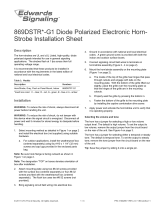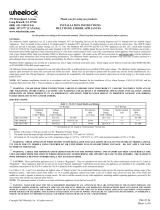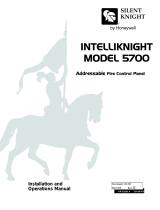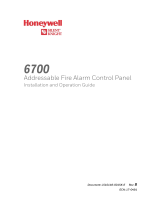Page is loading ...

1 I56-6515-002
10/02/2018
BEFORE INSTALLING
Please read the System Sensor Audible Visible Application Reference Guide,
which provides detailed information on notification devices, wiring and
special applications. Copies of this manual are available from System Sensor.
NFPA 72 and NEMA guidelines should be observed.
Important: The notification appliance used must be tested and maintained
following NFPA 72 requirements.
GENERAL DESCRIPTION
System Sensor series of notification appliances offer a wide range of audible
and visible devices for life safety notification. Our 4-wire horn strobes come
with 10 field selectable tone and volume combinations and 7 field select-
able candela settings. Intended for indoor applications and approved for wall
mount installations only.
4-wire horn strobes are public mode notification appliances intended to alert
occupants of a life safety event. The horn is listed to ANSI/UL 464 require-
ments (public mode) and the strobe is listed to ANSI/UL 1638 (public mode).
System Sensor notification appliances are designed to be used in either 12
VDC, 24VDC, or 24V FWR (full wave rectified) systems. System Sensor AV de-
vices can be activated by a compatible fire alarm control panel or power sup-
ply. Refer to the appropriate fire alarm control panel manufacturer or power
supply for more information.
System Sensor wall 4-wire horn strobes are electrically backward compat-
ible with the previous generation, since 1996, of notification appliances.
They come enabled with System Sensor synchronization protocol which re-
quires connections to a power supply capable of generating the System Sen-
sor synchronization pulses, a FACP NAC output configured to System Sensor
synchronization protocol, or the use of MDL3 module to generate the syn-
chronization protocol.
FIRE ALARM SYSTEM CONSIDERATIONS
The National Fire Alarm and Signaling Code, NFPA 72, requires that all noti-
fication appliances, used for building evacuation installed after July 1, 1996,
produce temporal coded signals. Signals other than those used for evacuation
purposes do not have to produce the temporal coded signal. System Sensor
recommends spacing notification appliances in compliance with NFPA 72.
SYSTEM DESIGN
The system designer must make sure that the total current draw by the devices
on the loop does not exceed the current capability of the panel supply, and
that the last device on the circuit is operated within its rated voltage. The
current draw information for making these calculations can be found in the
tables within the manual. For convenience and accuracy, use the voltage drop
calculator on the System Sensor website (www.systemsensor.com).
When calculating the voltage available to the last device, it is necessary to
consider the voltage due to the resistance of the wire. The thicker the wire, the
smaller the voltage drop. Wire resistance tables can be obtained from electri-
cal handbooks. Note that if Class A wiring is installed, the wire length may
be up to twice as long as it would be for circuits that are not fault tolerant.
The total number of strobes on a single NAC must not exceed 69 for 24 volt
applications.
AVAILABLE TONES
System Sensor offers a wide variety of tones for your life safety needs, includ-
ing temporal 3 pattern (½ second on, ½ second off, ½ second on, ½ second
off, ½ second on, 1½ off and repeat) which is specified by ANSI and NFPA 72
for standard emergency evacuation signaling. .
To select the tone, turn the rotary switch on the back of the product to the de-
sired setting. (See Figure 1.) Available horn settings and sound output ratings
can be found in Table 1.
NOTE: The standard mini-horn sound is 3.1 kHz. The legacy sound of the
SpectrAlert Advance line is EM (Electro-mechanical): this hops frequencies
between 2Hz and 4Hz. For EM Coded positions, temporal coding must be
provided by the NAC. If the NAC voltage is held constant, the horn output will
remain constantly on.
FIGURE 1. AUDIO SELECTOR
A0473-00
INSTALLATION AND MAINTENANCE INSTRUCTIONS
Selectable Output
Four-wire Horn Strobes – Wall Mount
For use with the following models:
Standard Wall Mount Horn Strobes: P4RL, P4WL
PRODUCT SPECIFICATIONS
Standard Operating Temperature: 32°F to 120°F (0°C to 49°C)
Humidity Range: 10 to 93% Non-condensing
Strobe Flash Rate 1 flash per second
Nominal Voltage: Regulated 12VDC or regulated 24DC/FWR
Operating Voltage Range: 8 to 17.5V (12V nominal) or 16 to 33V (24V nominal)
Operating Voltage with MDL3 Sync Module: 8.5 to 17.5V (12V nominal) or 16.5 to 33V (24V nominal)
Input terminal wire gauge: 12 to 18 AWG
DIMENSIONS FOR PRODUCTS AND ACCESSORIES
WALL PRODUCTS Length Width Depth
Standard Horn Strobe
5.6" (143mm) 4.7" (119mm) 1.25" (32mm)
Standard device with SBBRL/WL Surface Mount Back Box 5.9" (149 mm) 4.9" (125 mm) 1.85" (47 mm)
NOTE: SBBRL/WL Surface Mount Back Box intended for standard horn strobes.
MOUNTING BOX OPTIONS
Standard 4-Wire Indoor Products: 4" x 4" x 1½", Double Gang, 4" Octagon, SBBRL/WL (wall)
NOTICE: This manual shall be left with the owner/user of this equipment.
3825 Ohio Avenue, St. Charles, Illinois 60174
800/736-7672, FAX: 630/377-6495
www.systemsensor.com
I56-6515-002

2 I56-6515-002
10/02/2018
FIGURE 3. LIGHT OUTPUT – FIGURE 4. VERTICAL
HORIZONTAL DISPERSION DISPERSION– WALL TO FLOOR
Degrees*
Percent of
Rating
Degrees*
Percent of
Rating
0 100 0 100
5-25 90 5-30 90
30-45 75 35 65
50 55 40 46
55 45 45 34
60 40 50 27
65 35 55 22
70 35 60 18
75 30 65 16
80 30 70 15
85 25 75 13
90 25 80 12
Compound 45
to the left
24 85 12
Compound 45
to the right
24 90 12
A0467-00
A0469-00
*Tolerance of ±1 degree is permitted.
Thisisgenerated textforfigtxt.
TABLE 1. HORN TONES
Pos Tone Volume Setting
1 Temporal High
2 Temporal Low
3 Non-Temporal High
4 Non-Temporal Low
5 3.1 kHz Temporal High
6 3.1 kHz Temporal Low
7 3.1 kHz Non-Temporal High
8 3.1 kHz Non-Temporal Low
9 Coded High
10 3.1 kHz Coded High
AVAILABLE CANDELA SETTINGS
System Sensor offers a wide range of candela settings for your life safety
needs. In order to select your candela output, adjust the slide switch on the
rear of the product to the desired candela setting on the selector switch. (See
Figure 2.)
The candela setting can also be verified by looking into the small window on
the front of the unit. See Table 2 for candela settings for wall products. All
products meet the light output profiles specified in the appropriate UL Stan-
dards. (See Figures 3 and 4.)
FIGURE 2. CANDELA SELECTOR
A0486-00
CURRENT DRAW AND AUDIBILITY RATINGS
The 4-wire device provides two independent circuits, one for the Horn and
another for the Strobe. The current draw for each Strobe setting is listed in
Table 3, and audibility ratings for each Horn Tone setting is listed in Table 4.
TABLE 3. WALL-MOUNT STROBE CURRENT DRAW (mA)
Candela
8-17.5
Volts
16-33 Volts
DC DC FWR
15 88 43 60
NOTE: Products set at 15 and 30
candela automatically work on ei-
ther 12V or 24V power supplies.
The products are not listed for
12V DC operation when set to any
other candela settings.
30 143 63 83
75 - 107 136
95 - 121 155
110 - 148 179
135 - 172 209
185 - 222 257
TABLE 4. HORN CURRENT DRAW (mA) AND SOUND OUTPUT - REVERBERANT (DBA)
Pos Tone
Volume
Setting
8-17.5
Volts
16-33 Volts
Reverberant
Sound Output (dBA)
DC DC FWR
8-17.5
V
16-33 V
DC DC FWR
1 Temporal High 39 44 54
84 89 89
2 Temporal Low 28 32 54
75 83 83
3 Non-Temporal High 43 47 54
85 90 90
4 Non-Temporal Low 29 32 54
76 84 84
5 3.1 kHz Temporal High 39 41 54
83 88 88
6 3.1 kHz Temporal Low 29 32 54
76 82 82
7 3.1 kHz Non-Temporal High 42 43 54
84 89 89
8 3.1 kHz Non-Temporal Low 28 29 54
77 83 83
9* Coded High 43 47 54
85 90 90
10* 3.1 kHz Coded High 42 43 54 84 89 89
* Settings 9 and 10 are not available on 2-wire horn strobes. Temporal coding must be provided by the
NAC. If the NAC voltage is held constant, the horn output remains constantly on.

3 I56-6515-002
10/02/2018
WIRING AND MOUNTING
All wiring must be installed in compliance with the National Electric Code
and the local codes as well as the authority having jurisdiction. Wiring must
not be of such length or wire size which would cause the notification appli-
ance to operate outside of its published specifications. Improper connections
can prevent the system from alerting occupants in the event of an emergency.
Wire sizes up to 12 AWG (2.5 mm²) may be used with the mounting plate. The
mounting plate ships with the terminals set for 12 AWG wiring.
Make wire connections by stripping about
3
/
8
" of insulation from the end of
the wire. Then slide the bare end of the wire under the appropriate clamping
plate and tighten the clamping plate screw.
We provide a wire strip guide. See Figure 5 for wiring terminals and strip
guide reference. See Figure 6 for wiring diagram.
CAUTION
Factory finish should not be altered: Do not paint!
CAUTION
Do not over tighten mounting plate screws; this may cause mounting plate
to flex.
FIGURE 5. WIRING TERMINALS, SHORTING SPRING, AND STRIP GUIDE
Shorting Spring
Strip Guide
WIRING TERMINALS
1. Negative (-). Line in and out
2. Positive (+). Line in and out
3. Positive (+). Line in and out
4. Positive (+). Line in and out
5. Negative (-). Line in and out
A0527-01
FIGURE 6. WIRING 4-WIRE PRODUCTS:
+
–
INPUT
FROM
FACP OR
PRIOR
STROBE
INPUT FROM
FACP OR PRIOR HORN
+
–
+
–
+
–
OUTPUT
TO NEXT
STROBE
OR EOL
OUTPUT TO NEXT
HORN OR EOL
A0366-01
SYSTEM WIRING
For 4-Wire installations, terminals 1, 2, and 3 connect to the strobe; terminals
4 and 5 connect to the horn. The horn and strobe circuits must be wired in-
dependently, and each circuit must be terminated with the appropriate EOL
device. (See Figure 6.) Removal of a notification device will result in an open
circuit indication on the strobe loop.
NOTE: A shorting spring is provided between terminals 2 and 3 of the mount-
ing plate to enable wiring checks after the system has been wired, but prior
to installation of the final product. This spring will automatically disengage
when the product is installed, to enable supervision of the final system. Only
available on indoor products(non K-series).
SHORTING SPRING FEATURE
System Sensor notification appliances come with a shorting spring that is pro-
vided between terminals 2 and 3 of the mounting plate to enable system con-
tinuity checks after the system has been wired, but prior to installation of the
final product. (See Figure 5.) This spring will automatically disengage when
the product is installed, to enable supervision of the final system.
MOUNTING AND REMOVING APPLIANCE
1. Attach mounting plate to junction box. (See Figure 7.)
2. Connect field wiring according to terminal designations. (See Figures 5 and 6.)
3. If the product is not to be installed at this point, use the protective dust
cover to prevent contamination of the wiring terminals on the mounting plate.
4. To attach product to mounting plate:
a. Remove the protective dust cover.
b. Hook the tabs on the top of the product housing into the grooves on
mounting plate.
c. Pivot the product into position to engage the terminals on the mounting
plate. Make sure that the tabs on the back of the product housing fully
engage with the mounting plate.
d. Hold product in place with one hand, and secure product by tightening the
single mounting screw in the front of the product housing.
INSTALLING A SURFACE MOUNT BACK BOX
1. The surface mount back box may be secured directly to the wall or ceiling.
Use of grounding bracket with ground screw is optional. (See Figure 8.)
2. The wall mount back box must be mounted with the up arrow pointing up.
(See Figure 9.)
3. Threaded knockout holes are provided for the sides of the box for ¾ inch
and ½ inch conduit adapter. Knockout holes in the back of the box can be
used for ¾ inch and ½ inch rear entry.
4. To remove the ¾ inch knockout, place the blade of a flat-head screwdriver
along the outer edge and work your way around the knockout as you strike
the screwdriver. (See Figure 11.)
NOTE: Use caution not to strike the knockout near the top edge of the
surface mount back box.
5. V500 and V700 raceway knockouts are also provided. Use V500 for low
profile applications and V700 for high profile applications.
6. To remove the knockout, turn pliers up. (See Figure 11.)
FIGURE 7. MOUNTING
A0528-01
FIGURE 8. SURFACE MOUNTING ON WALL
A0529-01

4 I56-6515-002
©2018 System Sensor. 10/02/2018
System Sensor
®
is a registered trademark of Honeywell International, Inc.
FIGURE 9. SURFACE-MOUNT BACK BOX UP ARROW
A0481-00
TAMPER SCREW
For tamper resistance, the standard captive screw may be replaced with a Torx
screw, ordered separately.
1. To remove the captive screw, back out the screw and apply pressure to the
back of the screw until it disengages from the housing. Replace with Torx
screw. (See Figure 10.)
FIGURE 10. TAMPER SCREW
T15 Torx
#6-32, 5/8"
SCREW-TMPR-50
A0478-01
FIGURE 11. KNOCKOUT AND V500/V700 REMOVAL FOR SURFACE
MOUNT BACK BOX
½ inch
or ¾ inch
Wire Mold Removal
A0465-01
A0466-01
The horn and/or strobe will not work without power. The horn/strobe gets its power
from the fire/security panel monitoring the alarm system. If power is cut off for any rea-
son, the horn/strobe will not provide the desired audio or visual warning.
The horn may not be heard. The loudness of the horn meets (or exceeds) current
Underwriters Laboratories’ standards. However, the horn may not alert a sound sleeper or
one who has recently used drugs or has been drinking alcoholic beverages. The horn may
not be heard if it is placed on a different floor from the person in hazard or if placed too
far away to be heard over the ambient noise such as traffic, air conditioners, machinery
or music appliances that may prevent alert persons from hearing the alarm. The horn
may not be heard by persons who are hearing impaired.
NOTE: Strobes must be powered continuously for horn operation.
The signal strobe may not be seen. The electronic visual warning signal uses an extremely
reliable xenon flash tube. It flashes at least once every second. The strobe must not be
installed in direct sunlight or areas of high light intensity (over 60 foot candles) where the
visual flash might be disregarded or not seen. The strobe may not be seen by the visually
impaired.
The signal strobe may cause seizures. Individuals who have positive photoic response to
visual stimuli with seizures, such as persons with epilepsy, should avoid prolonged exposure
to environments in which strobe signals, including this strobe, are activated.
The signal strobe cannot operate from coded power supplies. Coded power supplies
produce interrupted power. The strobe must have an uninterrupted source of power in or-
der to operate correctly. System Sensor recommends that the horn and signal strobe always
be used in combination so that the risks from any of the above limitations are minimized.
WARNING
THE LIMITATIONS OF HORN/STROBES
FCC STATEMENT
System Sensor Strobes and Horn/Strobes have been tested and found to comply with the
limits for a Class B digital device, pursuant to part 15 of the FCC Rules. These limits are
designed to provide reasonable protection against harmful interference when the equip-
ment is operated in a commercial environment. This equipment generates, uses, and
can radiate radio frequency energy and, if not installed and used in accordance with the
instruction manual, may cause harmful interference to radio communications. Operation
of this equipment in a residential area is likely to cause harmful interference in which
case the user will be required to correct the interference at his own expense.
For the latest Warranty information, please go to:
http://www.systemsensor.com/en-us/Documents/E56-4000.pdf
For Limitations of Fire Alarm Systems, please go to:
http://www.systemsensor.com/en-us/Documents/I56-1558.pdf
Speakers only: For the latest Important Assembly Information, please go to:
http://www.systemsensor.com/en-us/Documents/I56-6556.pdf
Warranty
Limitations of
Fire Alarm Systems
Speakers Only:
Assembly Information
SUPPLEMENTAL INFORMATION
/





